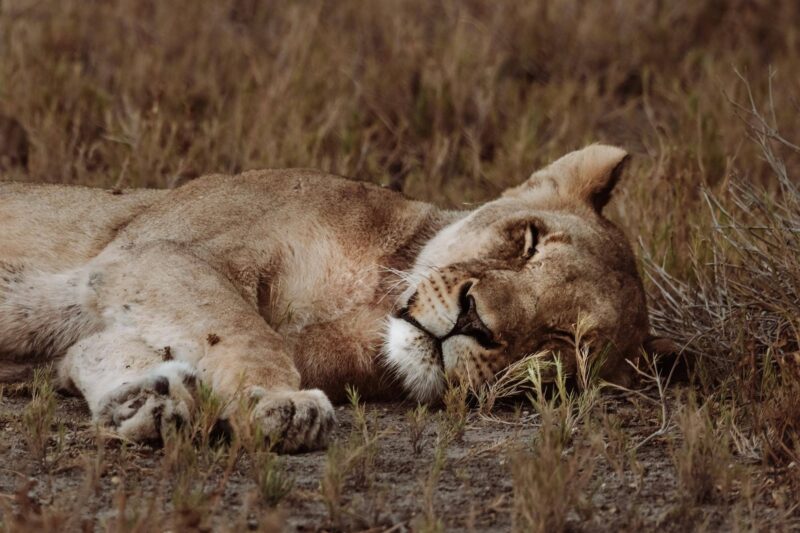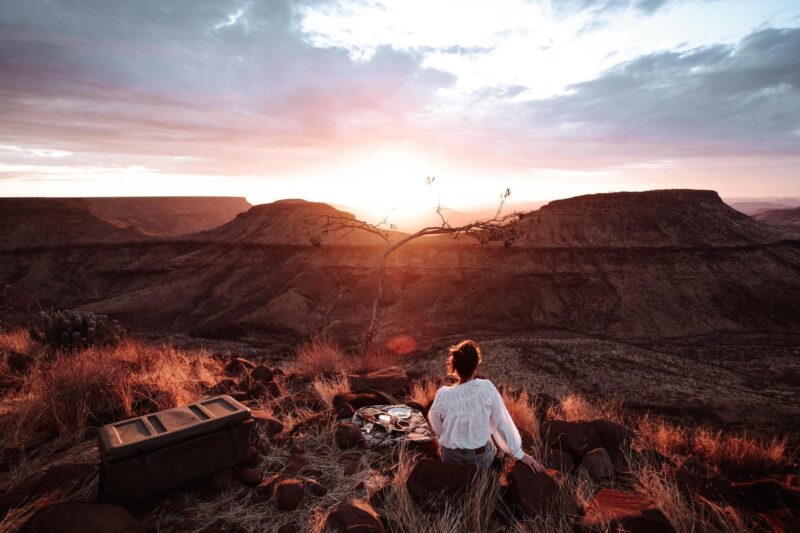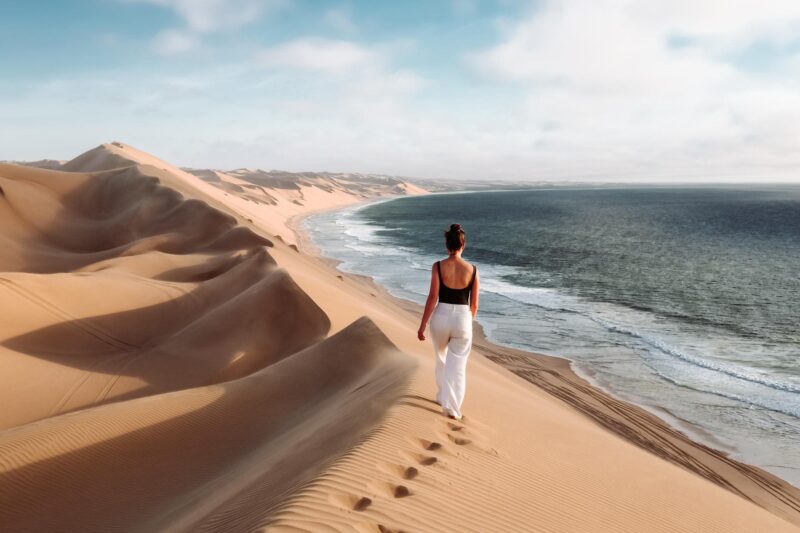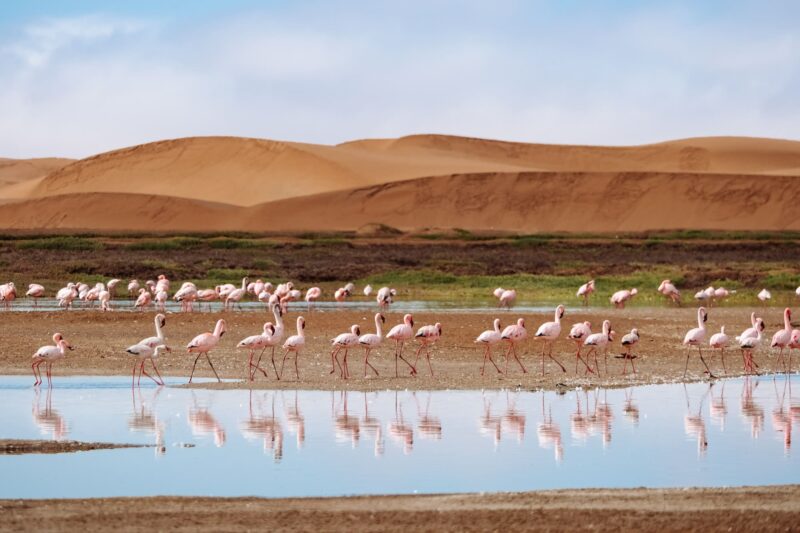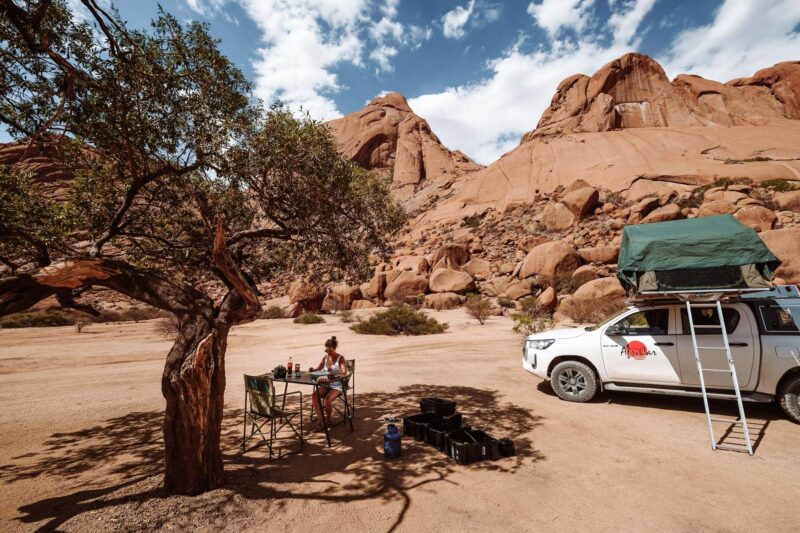A Roundtrip Through Namibia is One You’ll Never Forget. It’s one of the most sparsely populated countries in the world, consisting mainly of desert landscapes of sand and rock. That might sound like there’s not much to experience, but nothing could be further from the truth. During your road trip through Namibia, you’ll climb the world’s highest sand dunes, stay at the most unique locations, tour through the most beautiful mountain passes, and of course, encounter wildlife everywhere – both during safaris in wildlife parks and on your way to your next destination. Check out our Namibia travel itinerary and let the photos we took during our journey with Namibia Nomads convince you.
Transportation for this Itinerary in Namibia
Due to the very limited public transportation, there are only two ways to travel through Namibia: with a group tour by bus or by embarking on a self-driving road trip with a 4×4 rental car. In our opinion, the latter is absolutely the way to go. Driving is very easy and safe in Namibia, allowing you to experience the country at its best. You’ll encounter very few other cars on the road, and it’s even quite common to give a friendly wave when you meet oncoming traffic outside of the cities. This shows how sparsely populated the country is and how quiet the roads are. Sometimes, you can drive for hours without coming across anything or anyone. The landscapes constantly change and will surprise you rather than bore you.
Want to know more about what it’s like to drive in Namibia? Check out our tips for renting and driving a car in Namibia.
Choosing Between a Rental Car with or without a Roof Tent
Once you’ve decided to go on a self-driving adventure in Namibia, you’ll have another choice to make – whether to travel with a roof tent or not. This way of traveling is incredibly popular in Namibia, and it has several reasons. Firstly, the availability of lodges is limited, often being very luxurious and therefore pricey. Secondly, with your rental car and roof tent, you can stay at the most incredible locations in the heart of nature. You’ll do this at campgrounds where you often have your own space away from other cars. All camping gear is included with the rental car, so you can start your adventure through the land of endless horizons without too much preparation.
View our tips for camping with a 4×4 and rooftop tent in Namibia if this way of traveling appeals to you.
How Many Weeks Do You Need for This Itinerary?
There is a lot to see in Namibia, and distances can be quite significant. You could easily spend four weeks exploring, but that would likely consume all your vacation days. Most destinations are located in the northern and central parts of the country, and to visit these, you’ll need about two weeks. Below, we describe our Namibia travel itinerary, including all the places where you’ll stay and the stops you’ll encounter along the way.

Windhoek
You’ll most likely fly to the capital, Windhoek, where it’s best to purchase a SIM card with internet at the MTC shop right upon arrival at the airport. Next, withdraw some cash from an ATM in the city, and you’ll be fully prepared for your journey through Namibia. After a night’s rest from the flight, it’s time to pick up your rugged 4×4. You’ll receive a briefing about the car, the rooftop tent, and all the items in the vehicle, such as spare tires, a refrigerator, and other essential supplies. After the briefing, you’re ready for your adventure. Windhoek doesn’t offer much to do, so don’t linger here for too long. It’s a good idea to stock up on groceries so that you have enough food and drinks for the first few days.
Tip: You can do your major grocery shopping at SuperSpar Maerua in Windhoek.
Okonjima Nature Reserve
When you think of Namibia, you think of safaris. So, to start your journey off right, the first overnight stay on this itinerary is at the private Okonjima Nature Reserve. This vast 22,000-hectare piece of land has been in the Hanssens family for generations. They began as cattle ranchers but now work to protect wildlife and restore Okonjima to its natural state before human cultivation. In 1991, they founded the AfriCat Foundation, dedicated to rescuing, rehabilitating, and releasing large carnivores like leopards and cheetahs. After your first night in the bush, you can choose between a game drive or leopard tracking in the morning. Check out all the tips for Okonjima to learn about all the activities available.
Tip: In our opinion, it’s best to opt for the game drive because it allows you time to enjoy other animals as well. The guides communicate, so if the leopard tracking group spots a leopard, your guide will receive the location.
Namutoni (Etosha National Park)
After a taste of Okonjima Nature Reserve, continue your journey to Etosha National Park. This is one of Southern Africa’s largest game reserves and undoubtedly the best place to spot wildlife in Namibia. The landscape here is largely barren because 1/3 of the park consists of a salt pan that formed from the drying up of a massive lake. This makes it extra easy to spot animals. You can take an organized game drive or explore the entire park with your rental car. In Etosha, there are various camps where you can safely stay behind the fences. On the first night, you’ll stay in the eastern Namutoni camp, where you should definitely visit the so-called waterhole around sunset. Many animals like rhinos, elephants, zebras, lions, and giraffes come here to drink at this time. Check out our tips for Etosha National Park to make the most of your visit and spot the most animals.

Okaukuejo (Etosha National Park)
Wake up as early as possible on this day and leave as soon as the sun rises because the animals are most active in the early hours. Drive past various waterholes, take detours instead of the main roads, and scan the horizon for Namibia’s impressive wildlife. Today, you’re heading towards the western Okaukuejo camp, crossing most of Etosha in the process. The waterhole at Okaukuejo Camp is known as the best place to spot the black rhinoceros. They come here to drink almost every evening. Especially after dinner, be sure to take a look because evenings can be surprisingly busy. At one point, we saw two lions, five rhinos, seven giraffes, and a herd of springboks.
Grootberg
After a few days filled with safaris, it’s time for a change of pace. The next destination is the Grootberg Plateau located in the Damaraland region. In this area, you’ll find the desert elephant, the largest elephant species in the world. One of the activities you can do here is to seek out these giants. We opted for a different activity: the Santana (Sundowner) Drive. With a guide from the beautiful Grootberg Lodge, you embark on a journey across the flat Grootberg Plateau. The drive itself isn’t very thrilling, but in the end, you’ll arrive at one of Namibia’s most stunning viewpoints, where you’ll watch the sunset while enjoying your favorite drinks and tasty snacks. A magical moment! Check out our tips for Grootberg in advance to make the most of your visit.

Spitzkoppe
You’ll notice the diverse landscapes of Namibia when you drive from the Grootberg Pass to Spitzkoppe. The sharp rocks give way to gigantic round orange stones. In the middle of the vast plain, the Spitzkoppe mountain suddenly appears out of nowhere. This is the perfect place for an adventurous hike or climbing expedition. Here, you can camp among the giant rocks and witness the most beautiful sunsets. Check out our tips for Spitzkoppe to see all the things you can do and the most beautiful camping spots.


Swakopmund
If you didn’t already know that Namibia was once a German colony, you’ll quickly realize it in the peaceful town of Swakopmund. You’ll see the typical German architectural style in many old houses and government buildings. Swakopmund is the perfect base for a variety of exciting activities, such as a 4×4 tour through the desert at Sandwich Harbour, where the rolling sand dunes meet the sea. You can also go kayaking among the seals or quad biking in the Namib Desert. There’s plenty of fun things to choose from! We’ve listed the best things to do in Swakopmund for you.
Sesriem and Sossusvlei
Sesriem serves as the base for another highlight of this Namibia travel itinerary. The Sossusvlei is a unique place in many ways. Around 900 years ago, the valley was completely submerged by a massive river. Until the area was plagued by drought, and the fiery red sand dunes shifted so much that the river could no longer reach the Sossusvlei. The trees died and turned almost black from the sun, but they couldn’t decay due to the dryness. These trees are 900 years old! The swamps dried up, leaving behind the white clay bottom. The combination of colors makes this the most photogenic spot in Namibia. Check out our tips for Sossusvlei to make the most of your visit.
Tip: On your way from Swakopmund to Sesriem, you’ll pass by Solitaire Lodge. This is the perfect stop to refuel your car and yourself. The restaurant has a lot of delicious options on the menu.
Naukluft
Just before the end of your journey, make one last stop at Naukluft National Park. From here, you can embark on several short hikes through canyons, where you can take a refreshing dip in natural pools along the way. There’s a good chance you’ll encounter entire families of baboons along the way, watching you curiously from a distance. Be cautious with your belongings!
Windhoek
You return to Windhoek, where you reflect on an unforgettable adventure filled with highlights. We went for a bite to eat and some drinks at The Stellenbosch Wine Bar and Bistro, and in our opinion, it’s highly recommended. Enjoy delicious dishes and good wines in the patio with Mediterranean vibes. Reservation is required. If you prefer something simpler, Joe’s Beerhouse is a cozy place for one last drink in Namibia.
Tip: In Windhoek, they don’t use Uber but the local equivalent, LEFA. It’s handy to download the app in advance.
Where Did We Book This Journey?
We booked this trip with Namibia Nomads, and we can highly recommend it to everyone. Planning a trip through Namibia takes quite a bit of time because there are many things to consider. With Namibia Nomads, they take care of all the preparations, and you can start enjoying right away. You’ll receive a roadbook with all the information and tips for the journey. The price is competitive compared to other organizations, and everything is meticulously arranged. From airport pickup to a fully equipped 4×4 with a rooftop tent and camping gear, and all the accommodations. You travel individually through Namibia but start with other travelers on the same date. This group has its own WhatsApp group where you can share tips or meet up for a drink in the evenings if you wish. Nothing is mandatory, but if you find it enjoyable, you can take advantage of it. We found this to be a great addition to the trip.
























